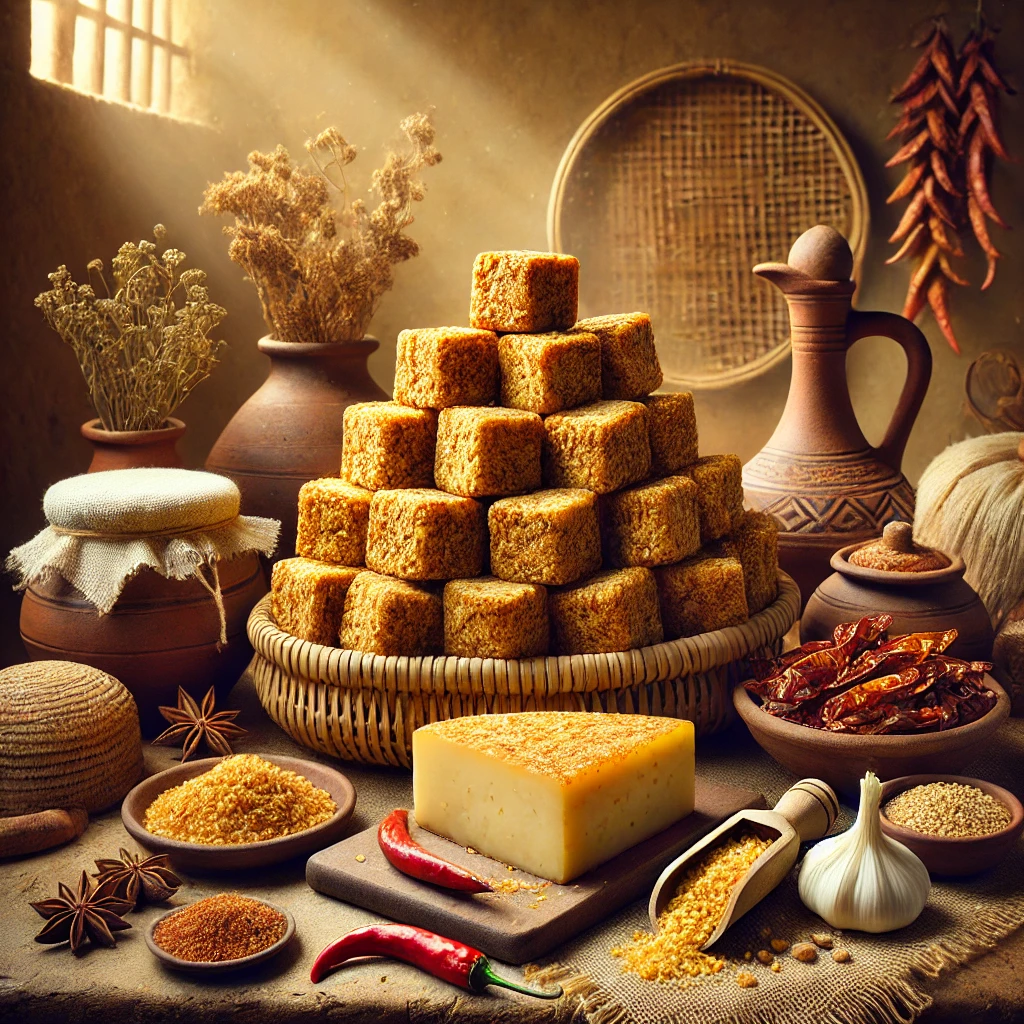Eritrea is a nation of rugged highlands, vibrant cultural traditions, and centuries-old foodways shaped by resilience and resourcefulness. Among its many culinary treasures, Gibna Sharmout—a traditional dried cheese—stands as an important symbol of Eritrean rural life. Tough, salty, and designed to last for months without refrigeration, Gibna Sharmout represents the ingenuity of Eritrean pastoral communities who needed food that could withstand the country’s varied climates.
Though much less known internationally than Italian ricotta salata or Middle Eastern jibneh, Gibna Sharmout offers its own story, flavor, and cultural depth. This guide explores how the cheese is made, why it has remained popular, how it is used in Eritrean cooking, and what makes it unique among the world’s traditional dried cheeses.
What Is Gibna Sharmout?
Gibna Sharmout—sometimes spelled “Gibna Sharmut” or “Jibna Sharmout”—is a traditional Eritrean dried cheese made from:
-
Cow’s milk
-
Goat’s milk
-
Or a mixture of both
It is heavily salted and air-dried until firm, giving it a long shelf life even in hot climates. The term sharmout generally refers to foods that are dried for preservation, such as dried meat (quanta). In the case of cheese, “sharmout” describes its distinctive sun-dried or air-dried form.
This cheese is valued for:
-
Durability
-
Nutritional richness
-
Simple ingredients
-
Ability to withstand long journeys and dry seasons
Historical Significance of Gibna Sharmout in Eritrean Culture
Before refrigeration, communities in East Africa relied on natural preservation techniques to store surplus foods. Milk, a highly perishable product, needed to be transformed into something stable.
Eritrean farmers and herders developed Gibna Sharmout as a solution:
-
Milk was plentiful during rainy seasons.
-
Drying preserved it for use during dryer months.
-
Salt acted as a natural preservative.
-
Dried cheese could be easily transported across long distances.
The cheese became a vital food source for:
-
Traveling herders
-
Nomadic groups
-
Rural families
-
Soldiers in historic conflicts
Its practicality made it a central part of Eritrea’s food heritage.
How Gibna Sharmout Is Made: Traditional Preparation Methods
While modern variations exist, true Gibna Sharmout is still made in rural regions using simple, time-tested techniques.
1. Milk Selection
Most families use whatever milk is available:
-
Cow’s milk (milder and softer)
-
Goat’s milk (stronger and tangier)
Milk may be fresh or slightly soured, depending on preference.
2. Heating the Milk
The milk is warmed over a wood fire until it reaches a gentle simmer, creating the environment necessary for curdling.
3. Curdling
Traditionally, natural acid (like sour milk) or an animal-derived rennet is added to separate curds from whey.
4. Draining the Curds
Curds are poured into cloth bags (commonly woven cotton or muslin) to drain overnight.
5. Salting
Salt is added generously to:
-
Draw out moisture
-
Prevent spoilage
-
Enhance flavor
Salt levels vary by region—some families prefer extremely salty cheese for longer preservation.
6. Shaping
The cheese is shaped into:
-
Small discs
-
Rectangular blocks
-
Irregular chunks
7. Drying
The cheese is placed outdoors on a mat or hung in shaded, airy spaces. Drying can take:
-
Several days in hot conditions
-
One to two weeks in cooler climates
The final product becomes hard, firm, and durable.
8. Storage
Once fully dried, Gibna Sharmout can be stored for months without refrigeration, especially if kept in sealed containers or cloth sacks.
Flavor Profile: What Does Gibna Sharmout Taste Like?
Gibna Sharmout has a bold flavor and a unique sensory profile.
Taste Characteristics
-
Salty and tangy
-
Slightly nutty
-
Complex from drying
-
Sometimes smoky if dried near wood fires
Texture
-
Firm to hard
-
Dense and compact
-
Grates or crumbles when chopped
-
Not creamy—it is closer to Parmesan or ricotta salata
Because it is so salty, it’s often used in small amounts as a flavor enhancer.
How Gibna Sharmout Is Used in Eritrean Cuisine
While some families enjoy it as a snack, Gibna Sharmout shines in dishes where its strong flavor can be balanced by other ingredients.
1. With Injera
Eritreans often crumble Gibna Sharmout over injera, adding saltiness and depth to the meal.
2. As a Topping for Stews
It’s used to garnish dishes such as:
-
Zigni
-
Shiro
-
Hamli
-
Lentil stews
The cheese softens slightly but does not melt.
3. In Pancake-Style Dishes
Some rural regions mix Gibna Sharmout with flour and eggs to create fried or baked cheese patties.
4. With Vegetables
Chopped dried cheese can be added to:
-
Tomato salads
-
Greens
-
Cucumber dishes
5. Snacks and Travel Food
Because it lasts so long, Gibna Sharmout is favored for:
-
Long journeys
-
Field work
-
Survival food
-
Military provisions (historically)
Nutritional Benefits of Gibna Sharmout
Gibna Sharmout is highly nutritious due to its concentrated form.
Rich in
-
Protein
-
Calcium
-
Essential minerals
-
Healthy fats
-
Fat-soluble vitamins
Low Moisture
Drying removes water, increasing nutrient density.
Long Shelf Life
A crucial benefit in regions without constant refrigeration.
Probiotic potential
If made from fermented milk, it contains beneficial bacteria.
The only caution: high salt content, which means moderation is key.
Comparison: Gibna Sharmout vs. Other Dried Cheeses
| Cheese | Region | Similarity | Difference |
|---|---|---|---|
| Ricotta Salata | Italy | Moderate | Less salty, smoother texture |
| Queso Añejo | Mexico | Moderate | More crumbly, milder |
| Chhurpi | Nepal & Bhutan | High | Much harder and chewier |
| Jibneh Mshallaleh (dried) | Middle East | Moderate | Usually pulled or layered cheese |
Gibna Sharmout sits comfortably within the global family of preserved cheeses yet maintains its own distinct identity.
Modern-Day Role of Gibna Sharmout
In urban Eritrea—particularly in Asmara and Massawa—refrigeration and imports have expanded cheese choices. Still, Gibna Sharmout remains important for:
-
Cultural traditions
-
Rural households
-
Festivals and holidays
-
Home-cooked meals
-
Diaspora communities
Artisanal cheesemakers and small dairies are reviving interest by offering:
-
Mildly dried versions
-
Spiced varieties
-
Goat-specific batches
This renewed attention helps preserve a fading culinary tradition.
Storing and Using Gibna Sharmout at Home
Storage Tips
-
Keep in an airtight container
-
Store in a cool, dry place
-
Avoid moisture exposure
Properly dried cheese can last months without spoiling.
How to Use
-
Grate over salads
-
Chop into soups or stews
-
Pair with bread or injera
-
Crumble over vegetables
Because of its saltiness, minimal quantities go a long way.
Why Gibna Sharmout Matters: Heritage in Every Bite
Gibna Sharmout is more than a preserved cheese—it encapsulates:
-
Resilience
-
Efficiency
-
Traditional knowledge
-
Resourceful food preservation
-
Pastoral culture
Each batch reflects the conditions of the region, the skills of the maker, and the longstanding relationship between Eritrean communities and their land.
Conclusion: A Timeless Eritrean Dairy Tradition
Gibna Sharmout remains one of Eritrea’s most distinctive traditional foods. Its salty, dried character connects modern Eritreans with their ancestors, who crafted durable foods suited to travel and survival in challenging climates. Today, the cheese continues to enrich meals with its deep, savory flavor, whether sprinkled onto injera, added to stews, or enjoyed on its own.
As global interest in artisanal and heritage foods grows, Gibna Sharmout offers a unique opportunity for food lovers to explore Eritrea’s culinary landscape—one preserved piece at a time.



